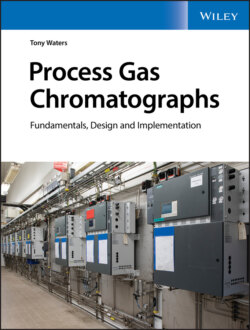Читать книгу Process Gas Chromatographs - Tony Waters - Страница 27
Multiple columns
ОглавлениеThe choice of separating column is always the key to a successful analysis. In practice, it's difficult to achieve the desired separation using just one column, so process gas chromatographs usually employ multiple columns to achieve the necessary separation in the shortest possible time.
With multiple columns, certain partially separated components from one column must flow into another column to achieve the desired separation. To divert flows between columns, an online gas chromatograph typically uses one or more column valves that are usually similar in design to its sample injection valve. Figure 1.5 shows an example of a simple column system.
For simplicity, the figure shows a rotary valve that rotates 90° when actuated, thereby flushing later peaks to vent. Other valves have a similar function.
Figure 1.5 A Simple Column Switching System.
Intercolumn valves must not leak. They must also have very low internal volume and smooth flow paths, lest separated components start to remix. For the same reason, a PGC typically employs ‐inch o.d. tubing for all its internal plumbing.
PGCs are individually configured for a particular application. During this procedure, known as application engineering, the application engineer chooses a column system to perform the desired separation and decides on the stationary phase needed for each column. Refer to Chapter 9 for a review of some standard column configurations and the function of each column.
